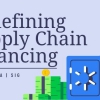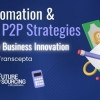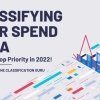Businesses need faster and more comprehensive spend management solutions, without the need for additional subject matter experts. To this end, our clients have benefited from improvements in insight and service delivery using 4C’s analytics platform 4Spend. Here are ten ways in which new savings can be found using analytics.
1.) Categorisation and Benchmarking
Correct categorisation of the supplier spend data into recognised procurement categories is fundamental. This requires both a standard taxonomy to enable benchmarking and client specific taxonomy so that the client can recognise and understand the spend pattern.
Once correctly categorised it is possible to draw insights that prompt investigation. For example, higher third-party costs in a category are a feature of Business Process Outsourcing (BPO), and if it is alongside a high cost-per-head benchmark, then it requires explanation.
So, rather than saying “We think you could reduce costs in IT,” it is possible to see from the data that there is IT outsourcing in place and yet the spend per head on IT is in the upper quartile for businesses of that size and sector. This enables procurement to target particular levers to achieve the potential saving.
2.) Supplier Normalisation
To leverage your total spend with a particular organization it is vital to bring together the spend from multiple related entities into a single view. Supplier normalisation is a process we use to identify suppliers in a data set that are either different spellings of the same supplier, related entities or companies that share a joint parent company. For example, a data set may have different spellings as well as several different regional or operational entities. In addition, there may be spend with suppliers that are owned by the same parent company. Supplier normalisation provides the intelligence you need to negotiate with suppliers based on a complete spend picture.
3.) Spend Fragmentation
What is the right number of suppliers in a particular subcategory and when should you consolidate to negotiate savings? First, you need a measure for supplier concentration across all subcategories; then you need procurement intelligence to determine concentration thresholds for each subcategory.
The Herfindahl-Hirschman Index (HHI) is a suitable standard that is more commonly used by regulators to determine market competitiveness. The HHI concentration is calculated across the spend portfolio, categories, subcategories, countries, and business lines and compared to concentration thresholds.
To illustrate this concept, consider two subcategories -- cleaning and recruitment, both having an HHI of 2,000. An alert would be triggered on cleaning that supplier consolidation is a potential lever in this subcategory, as we are generally seeking to minimise management charges and leverage scale. Whereas recruitment would not trigger an alert since we know that using several agencies can be a good strategy for achieving reach and you generally only pay on success, therefore a more fragmented subcategory is not necessarily a bad thing.
HHI can be combined with other measures to embed more sophisticated procurement intelligence. Extending the example above, if the recruitment HHI of 2,000 is combined with high spend and client headcount, then the combination of these factors may alert us that consolidation of spend through a BPO is a potential savings lever.
4.) Projects Database
If you have a database of all the savings projects that you have ever run, then you can highlight when suitable projects might be appropriate and provide a range of possible pay-offs. You need your procurement intelligence embedded by tagging each project with both the procurement lever(s) that they exploit and other contextual parameters, such as the procurement maturity of the client and sector.
You will be familiar with using the expertise of category managers to examine the context and modify suggested projects accordingly. Expert systems can be designed to capture this kind of expertise to improve the diagnostic speed and highlight savings potential more accurately.
5.) Category Management
Comprehensive category management takes time and energy from high-quality staff. If you have a system that provides wide-ranging category research, then you can encourage “outside in” thinking for them as they pull together category plans and strategies. You need a system providing complete access to market analysis including drivers and constraints, category inflation, innovations, and Porters Five Forces analysis across all subcategories and geographic regions.
The concept is to embed the attributes of a good category subject matter expert within the system, thereby allowing more time for thinking creatively, category planning and fuller savings regimes.
6.) Contract Analysis
How many times have you missed a window of opportunity for negotiation on an expiring contract and had to allow the contract to roll-over? Using machine learning to extract metadata from the contract documents improves visibility and ensures that renewals are planned, and alternative suppliers are considered in good time. For ongoing contracts with material spend, you need to know if the supplier is performing. In this case, the system will trigger an alert to test the stakeholder satisfaction with the supplier. If the satisfaction with the supplier is high, an alert to consider whether an extension on better terms can be negotiated. If the client is unhappy, then an alert to manage SLA’s (Service Level Agreement) is triggered to either recover service credits or find grounds for service reduction and/or termination.
It is also important to identify the anticipated annual contract value when the contract was established and compare it to the actual spend. Where spend is significantly in excess of what was expected, an alert can be triggered to suggest a review of the commercials.
Finally, we assess the proportion of spend that is being put out to competition with an analysis that highlights high occurrences of contract renewals with the same supplier as well as any direct awards without a tender process.
7.) Purchase Order (PO) Compliance
Non-compliant or maverick spend is a perennial problem that can be improved using analytics. Analytics can be used to manage policy thresholds, ensuring that POs that should be reviewed by procurement are indeed routed in that manner. Analytics can also be used to check the date of a PO against the matching invoice to identify “Retros,” – which are POs set up after the invoice has been submitted.
Maverick spend occurs when people think it doesn’t matter that they don’t follow a process and/or they won’t be sanctioned for non-compliance. Efficiently providing measures is a great way to bring maverick spend under control.
8.) Period-on-Period Growth
When you are growing your business with a supplier you can consider asking them for better terms and perhaps rebates, but how do you spot these automatically? Use analytics that allows the user to define a threshold and view all suppliers in their category that have grown by over that threshold either year to date or on a trailing 12-month basis.
In addition, from a risk perspective, it allows us to identify essential suppliers where risk checks should be raised in line with their increasing significance to the business.
9.) Savings Project Management
It is important to note that forecast benefits are only of any value to your business if they are delivered. To achieve this requires best-in-class governance across all projects and embedded procurement intelligence. To achieve this, use a project management tool that supports every stage of a savings project. Ensure excellent governance and visibility of forecast benefits, including whether they are P&L impacting, their phasing within your fiscal periods, their fungibility and which stakeholder budget it relates to.
10.) Operational KPIs – “Vital Signs”
You may well have KPIs, but are they updated continuously and automatically? To achieve continuous updates requires a system that collapses the manual effort of analysis and has embedded procurement intelligence. This approach transforms spend analysis from a project undertaken occasionally to an “always on service” that considers invoice, PO, Project, Contract, Risk & SLA data to provide a suite of operational KPIs and governs the procurement process relentlessly, thus allowing you continuous monitoring for savings opportunities.
The above are some of the many ways in which new savings can be found using analytics.
Organizations have developmented systems that can help us make the step from descriptive analytics to prescriptive analytics and deliver results. We are only on the cusp of this type of savings method. A study at a large teaching hospital in London has compared the performance of a machine learning system and skilled technicians’ effectiveness in the assessment of brain scans for abnormalities. Technicians were slower but had a lower percentage error rate. Machine learning was faster but had a higher percentage error rate. Together, they complimented each other beautifully and the combined result was speedier analysis and a lower error rate. This is the approach the we aspire to achieve, where our machine learning does the analytical hard yards and then the user exercises sound procurement judgement. More prescriptive analytics based on procurement intelligence are in the pipeline and predictive analytics are coming into focus. Who said that procurement is tedious?
Region:









